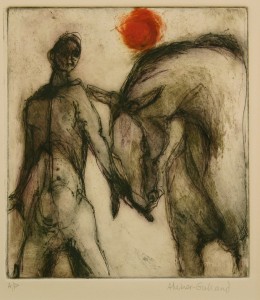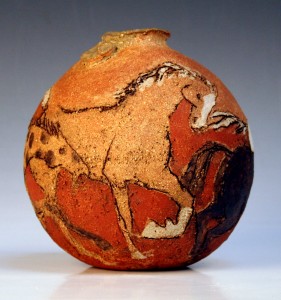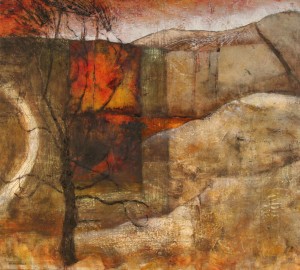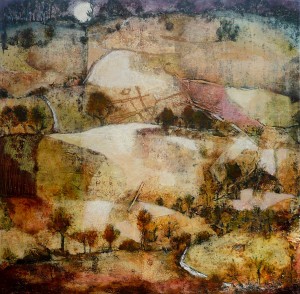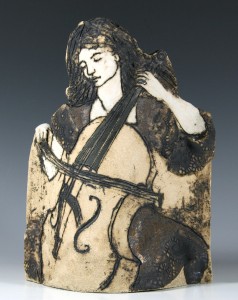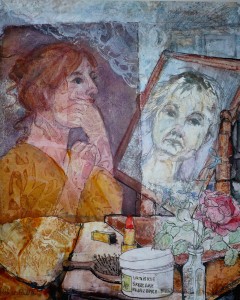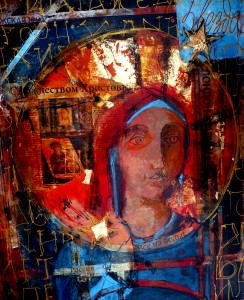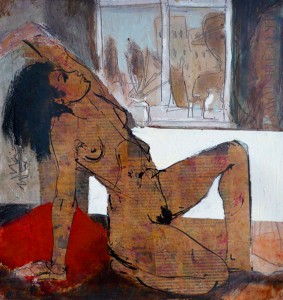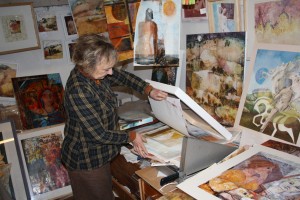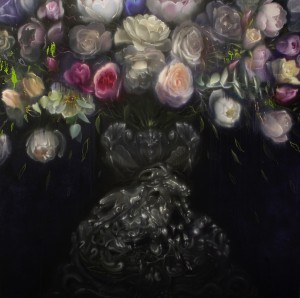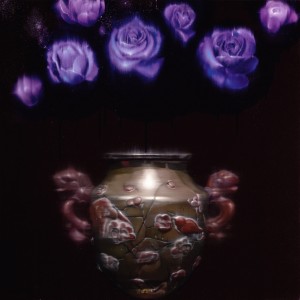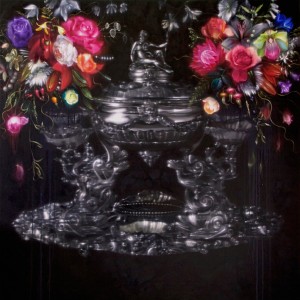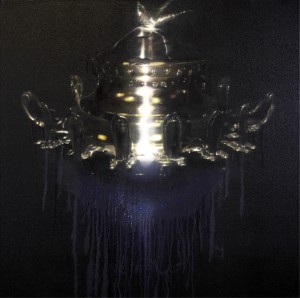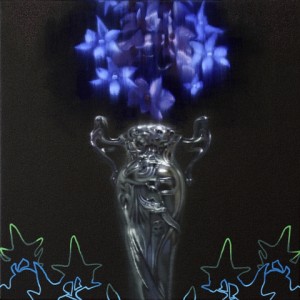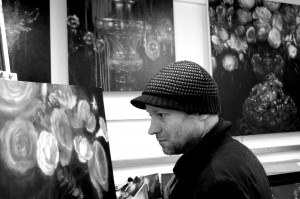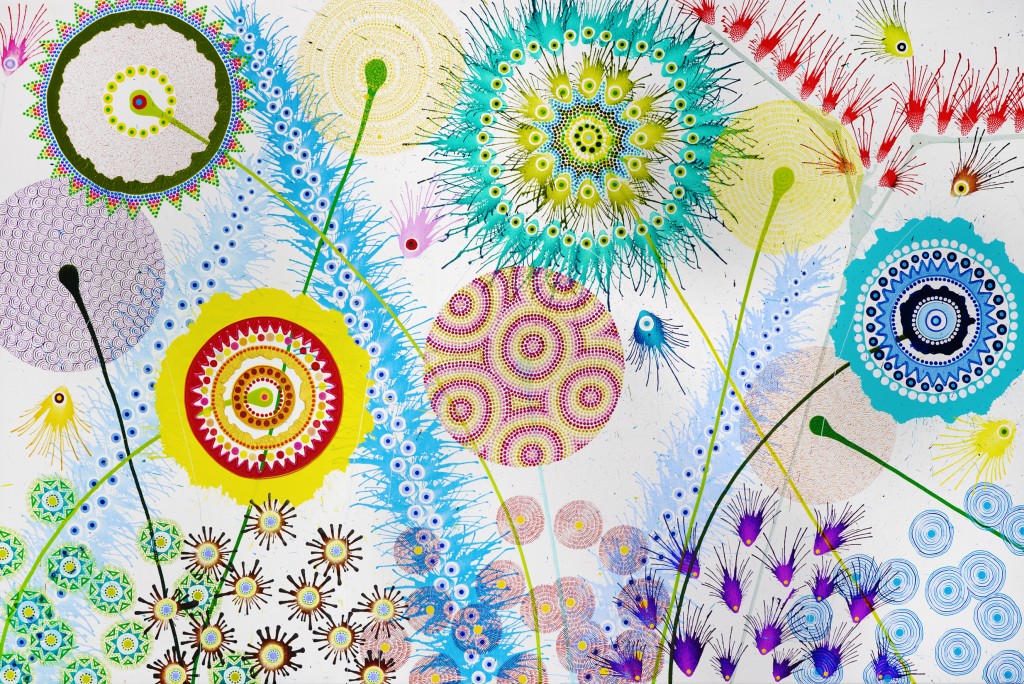
Nicholas Toovey is the painting and book specialist at his family’s firm of fine art and antique auctioneers and valuers. Here he talks about his forthcoming contemporary art auction, to be held at Toovey’s Spring Gardens auction rooms on May 28th. He also discusses the reasons behind hosting this innovative sale.
I have been fortunate to grow up surrounded by art. Regularly visiting museums and galleries from a very young age, my parents inform me that I saw some amazing exhibitions from my pushchair. I have early memories of Giverny, mainly stomping over a blue bridge rather than looking at lily pads. Similarly, I vaguely remember seeing pictures of horses in a cave at Lascaux and thinking I could do better – I couldn’t, even today. One of the earliest memories of a painting that has stuck with me was seeing Henri Matisse’s ‘L’Escargot’ at the Tate. The bold use of colour and the fact that he was in ill-health when he made this vast work has always impressed me.
Whilst I appreciate all art, through my personal exploration of its history I found one particular area that I adore above all others, the British watercolour tradition. It is arguably the first period where Britain led the way in the history of art. Our nation of artists promoted the watercolour medium to one that was worthy of finished paintings. The artists of the day infused our landscape with poetry, melancholy, reverence and atmosphere. Names such as John Robert Cozens, Joseph Mallard William Turner, John ‘Warwick’ Smith and Francis Towne have produced some of my favourite paintings. Thomas Girtin was another from this era of talented artists. He painted ‘The White House at Chelsea’, a small unassuming watercolour located down a side corridor at Tate Britain, which happens to be my favourite ever painting. I also love the patrons of this date, especially Dr Thomas Munro, who set up an informal academy at his home on Adelphi Terrace. Here he made the work of Cozens, one of his patients in Bethlem Hospital, available for study by the next generation of watercolourists.
With this love of late 18th and early 19th century watercolours, many people are surprised by my unwavering passion to promote contemporary art. In my head I hold a romanticized vision of Munro as a selfless promoter; I feel a similar self-imposed duty to promote the artists of today for the future. It was with this in mind that I created Toovey’s Contemporary Art Auctions. The auctions only include works of art consigned for sale directly from the artists, an entirely new concept that was totally unique when the first sale was held in 2006. Conceived through my desire to offer a new platform for artists to exhibit and sell their work, the sale also offers an exciting way for art-lovers, collectors and patrons to acquire contemporary art. There is nothing quite like the adrenaline rush of bidding on a lot at auction. It is the best form of gambling around, if you win you get to take something beautiful that you really wanted home with you, if you lose you don’t pay a penny!
I have organised preview exhibitions of the sales at local museums, joining the dots between artists, buyers, museums and auctions. This year the majority of entries are housed in the preview exhibition ‘Hung, Drawn & Displayed’ at Horsham Museum, which runs until 11th May. The medieval timber-framed building in Horsham’s picturesque Causeway provides a contrasting backdrop to the diverse selection of 21st century art.
Another aim of the sale is to promote the arts in Sussex and make contemporary art more accessible. My biggest concern is that for many the term contemporary art conjures visions of unmade beds or diamond encrusted skulls, this often leads to bewilderment and a misunderstanding of art today. Exhibition pieces such as these are used in the same way a car manufacturer will produce a concept car that will never go into production. I feel it is important to remember that contemporary art is simply a term that covers art created in our recent lifetime. Contemporary art therefore encompasses a huge spectrum of work, from more traditional pieces to radical and innovative art.
The auction offers a perfect starting place to venture into the contemporary art market; with 60 highly talented artists providing a wide variety of styles. The selection of 170 original works of art is a truly eclectic mix and I hope that even if you do not like some of the works, you will be able to appreciate the technique or skill of the artist. Similarly I hope you will fall in love with a few pieces and have just the right home for them, fortunately everyone has different taste and as curator I attempt to reflect that. The selection process is carefully considered and I draw upon my knowledge of fifteen years experience in the resale art market when contacting and responding to artists. I dedicate a considerable amount of my personal time to organise the event and to source a mixture of highly acclaimed names and emerging talent. I also believe art should be inclusive and so the auction caters for all budgets, with work carrying presale estimates between £50 and £8000.
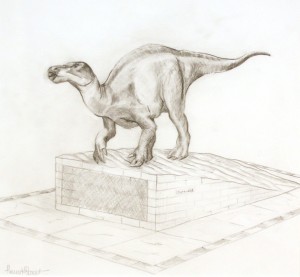
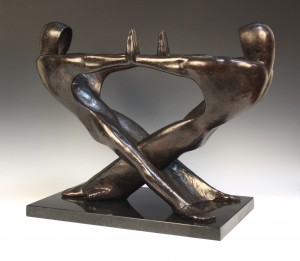
The Contemporary Art Auction this year includes the work of award-winning Horsham-based artist Hannah Stewart. Hannah is best known for her public sculptures, including ‘Hauling Man’, a life-size sculpture at the Tesco store in Hailsham, which celebrates the rope-making tradition in the area. ‘The St Leonard’s Forest Dragon’ in Horsham Park is also one of her pieces, produced for the town in which she was born. This year Hannah is offering three preliminary drawings for her work in 3-D, one of which is the original sketch for ‘Southwater Iguanodon’. The finished sculpture in Southwater reflects the local brick-making tradition in its base and the discovery of the dinosaur bones in the surrounding area. This drawing shows a slightly different plinth to that produced and now on display in the Lintot Square. The drawing was used for promotional material at the unveiling and provides a rare opportunity to acquire a piece of local history.
Whilst Hannah is offering preliminary drawings, fans of sculpture can still delight in a fantastic and diverse selection, including two bronzes by Hove-based sculptor William Harling. Form is paramount in William’s work, as ‘Chromosome’ exemplifies. This large 61cm (2ft) wide foundry-cast bronze group of two anonymous cloaked figures joined in a striking ‘x’ outline is testament to the sculptors’ skill and considered vision. Their faceless appearance strips the figures of all personality and individual history, hinting towards a metaphysical symbolism.
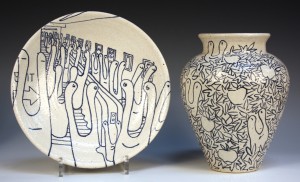
Work in ceramics is not neglected in the sale. Often deemed as craft rather than art, I choose ceramicists whose work crosses this boundary. Arundel-based ceramicist, Josse Davis, has featured in every auction to date and this year is no exception. He is the son of the famous ceramicist and artist Derek Davis and the painter Ruth Davis. Having been born into a world of colour and form, Josse was always destined to be creative. This year he is offering three pieces from his Alien-themed series, produced in stoneware with brush-drawn decoration in soot-black pigment. This humorous range of work shows how strange some of the things humans do in our day-to-day lives appear.
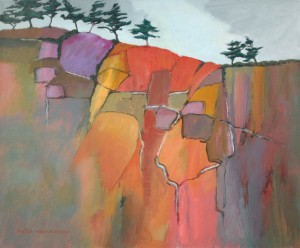
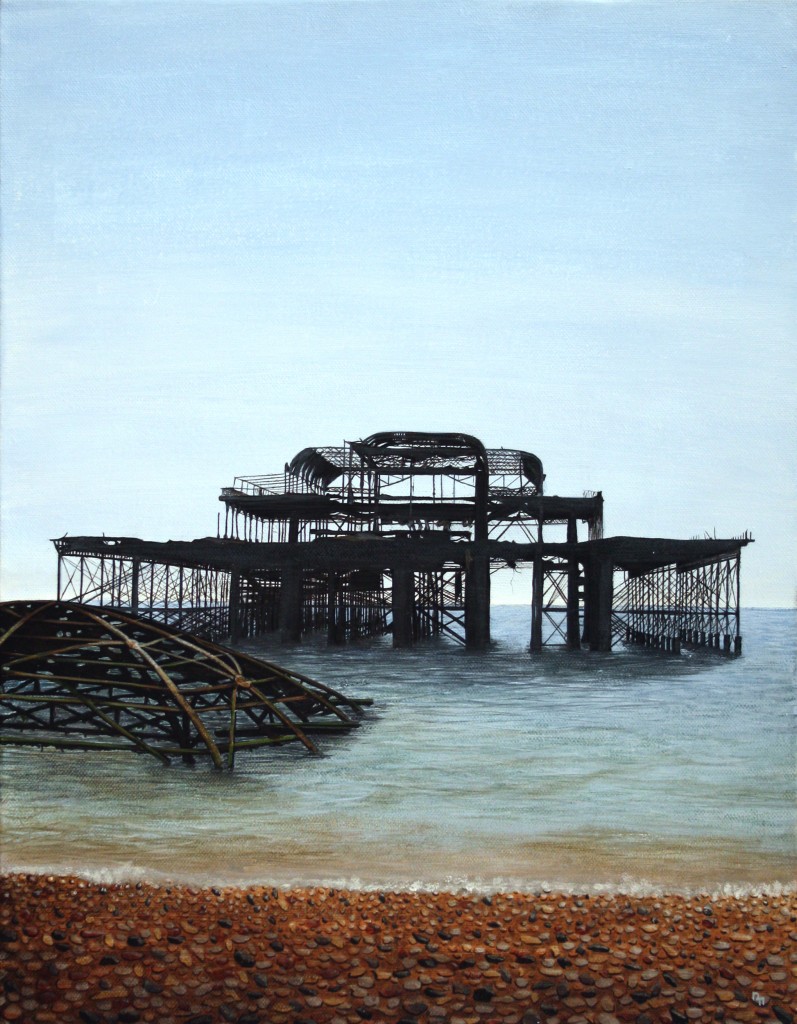
Inherently pictures are strongly represented within the sale; always offering a mixture of sizes, styles and media, including quirky illustrations, traditional watercolours and urban-inspired oils on canvas. West Sussex artist Sheila Marlborough is offering a group of paintings including ‘Wandering Paths’. The abstract canvas is an atmospheric interpretation of a landscape that highlights her strong compositions and love of emotive colour. Sheila was elected as president of the Sussex Watercolour Society in 2005 and is also a member of the artist-led co-operative Chalk Gallery in Lewes. In contrast, Natalie Martin’s incredibly detailed and realistic paintings capture urban decay and domestic neglect in a beautiful and revered way. The subject of her acrylic on canvas ‘The West Pier at Brighton, no 3’ exemplifies her expression in art perfectly. Natalie is often described as a ‘painter’s painter’ and has had work accepted by the Bath Society of Artists, The Society of Women Artists and The Royal Academy.
I am always seeking new artists of a high calibre to keep every auction fresh and different from the previous year. A new face participating this year is Dan Bennett, another Brighton-based artist whose meticulously executed paintings on canvas are inspired by his fascination with phosphenes. These intricate swirling patterns that dance across closed eyelids have been the mainstay of his artistic production to date, often translating these spirals, dots and meandering lines into more recognisable subjects such as plants and other organisms. Dan’s work shares strong links with Aboriginal dot paintings, African body art and examples seen in lost cultures in the ancient world, such as those in the Peruvian rainforests. His painting ‘delphinium3’ is one of three works he has entered in the sale highlighting his own unique vision.
I believe art comes alive when you know more about it, I am therefore happy to relay any inherited stories I have been told by the creators. I will be available on the above viewing times to discuss any items within the sale. A fully-illustrated catalogue is also available with further information on all the participating artists and their work. Visit www.tooveys.com for further information.
Nicholas’ article was originally published in Sussex Life magazine in May 2011.
